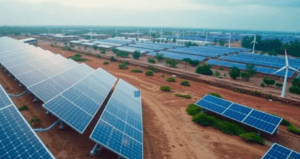How India Can Dominate Clean Energy: 5 Bold Steps to a $100 Billion Export Powerhouse
India has a unique opportunity to become a global leader in clean energy, just as it transformed digital payments with UPI. Currently, the country spends over $130 billion annually on oil and gas imports, weakening its economy and increasing inflation. However, the global energy landscape is shifting toward renewables, and India can capitalize on this by building an international electricity network. With advancements in HVDC transmission, battery storage, and undersea cables, cross-border electricity trade is becoming a reality.
India’s One Sun One World One Grid initiative is already laying the foundation for this transition, with existing power links to Nepal, Bhutan, and Bangladesh. Expanding this network to Saudi Arabia, Japan, and eventually Europe could position India as a major electricity exporter. The key challenge lies in energy storage, but falling battery costs and hydropower solutions present viable options. By investing in transmission infrastructure and domestic manufacturing, India can turn its energy dependence into dominance, potentially becoming a $100 billion clean energy powerhouse by 2047.

How India Can Dominate Clean Energy: 5 Bold Steps to a $100 Billion Export Powerhouse
India stands at a pivotal moment, poised to lead the world’s shift to clean energy, much like its groundbreaking success with digital payments through UPI. The nation currently spends over $130 billion annually on oil and gas imports—a drain on its economy that weakens the rupee and fuels inflation. Reducing this dependency isn’t just about cutting costs; it’s a strategic leap toward economic resilience and global leadership.
The Global Energy Shift
The world is rapidly transitioning from fossil fuels to renewable energy sources like solar and wind. Yet, unlike oil—traded globally—electricity remains confined within borders due to the absence of international transmission networks. This barrier is now breaking down, thanks to advancements in high-voltage direct current (HVDC) technology, cutting-edge battery storage, and undersea cables capable of transmitting power across continents. These breakthroughs could soon allow countries to share clean energy seamlessly.
India’s Renewable Energy Vision
India has already laid the groundwork for this future through its One Sun One World One Grid initiative, which aims to create a global renewable energy network. With one of the world’s most robust power grids, India is investing heavily in infrastructure expansion and modernization. The country is already linked to Nepal, Bhutan, and Bangladesh, and the next step could be connecting to Saudi Arabia, which is integrating its grid with Egypt and Europe. Within five years, India could join the European grid, enabling a unified electricity market across Asia and Europe.
Tackling the Storage Challenge
A critical hurdle in this transition is energy storage. To achieve global net-zero emissions by 2050, the world needs 4,000 gigawatts of storage capacity—50 times the current level. While this requires massive investment, falling battery costs and India’s untapped hydropower potential present viable solutions. By integrating large-scale storage with cross-border transmission links, India can reduce its reliance on localized battery systems, lowering costs and improving efficiency.
Building a Clean Energy Ecosystem
To lead this transformation, India must strengthen domestic production of HVDC components, undersea cables, and energy storage technologies. The government should prioritize the development of HVDC corridors every few years, starting with links to Saudi Arabia and Japan and eventually extending to Europe. This strategy could establish India as a global hub for electricity trading, similar to its success in unifying domestic power markets.
Economic and Global Gains
By 2047, India could shift from being a $130 billion energy importer to a $100 billion clean energy exporter. This transformation would stabilize the rupee, reduce inflation, improve credit ratings, and drive sustainable economic growth. As the world embraces electrification, India’s strategic investments in renewables and global grid integration could position it as a leader in the energy transition.
The Road Ahead
The global energy landscape is evolving, and India has the resources, vision, and technological expertise to lead. By acting decisively—accelerating infrastructure projects, fostering innovation, and strengthening international partnerships—India can secure its place as a clean energy powerhouse. The time to act is now, turning ambition into action for a greener, more prosperous future.
In summary, India’s clean energy journey isn’t just about combating climate change—it’s an opportunity to redefine its economy, strengthen global ties, and inspire the world. The path is clear; bold steps today can electrify tomorrow’s possibilities.
You must be logged in to post a comment.